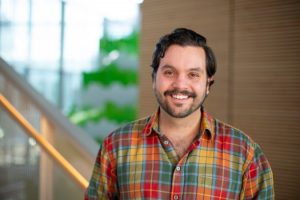SUPPORT DOWN TO EARTH! For as little as $3 per month you can help this show survive and thrive. Click HERE. Thank you!!
Omar de Kok-Mercado Scientist with background in Agro-ecology, Soil Microbiology and Biochemistry, and he’s at Iowa State University working on a project that integrates prairie strips into row-crop agriculture. By working with farmers to plant strips of land—”prairie strips—with native prairie vegetation, he and his team are working to bring back healthy soil, wildlife, corridors, a healthy water cycle, and innumerable potential benefits to land that is currently being cultivated in ways that are not sustainable in the long run.
1’50 origin story of the North American prairie
3’31 how Native Americans used and altered prairie land before colonialism
4’17 using fire on the landscape
4’56 native tree crops
5’29 abundant wildlife, pigeons blackening the sky
5’51 birds contributing to soil fertility
6’10 getting rid of “edges” … e.g. creating gradients between forest and pasture
7’52 losing resiliency in ecosystems in places like Iowa because of monocropping
9’18 the importance of embracing complexity
10’01 what are prairie strips
11’05 integrating strips of prairie into row crops
11’48 slowing down water is important, as is filtering water
12’43 prairie vegetation very diverse
13’10 habitat benefit of prairie strips
13’42 the birds and the bees
14’13 you can hear the corn growing
15’39 prairie as a set of perennial crops waiting for a market as well as conservation land
17’07 several gazillion ideas about how to use prairies
19’13 erosion mitigated by prairie strips, water infiltration and improvement
20’11 studying what’s happening in between the prairie strips, i.e. in the crop rows
21’19 the beauty of the prairie itself
21’38 people who use prairie strips are conservation minded and love their heritage–and want to restore it
22’40 living in the Anthropocene and integrating the different components of the landscape
23’43 putting prairie strips on land that is operating at a loss
25’16 housing beneficial insects on prairie strips–this needs further study
26’50 developing markets for perennials, and reducing chemical inputs
27’36 some “conventional” actually using better practices than some organic farms
28’58 putting prairie strips under utility lines and other placements
30’27 fencing was pulled out during the Earl Butz era when they put animals in buildings. Now it’s going the other direction
31’30 recreational trails, agro-forestry, lots of possibilities for using land for thing other than row crops
32’28 the problem of CAFOs and the reality that we’re not going to get rid of them any time soon
33’08 inconceivably huge amounts of manure from hog farms
33’45 how to leverage the manure? biogas digestion has still to be developed here, they do it in Europe
35’33 what’s involved in converting from row crop to livestock ag. The capital investments are a barrier to this
36’17 Omar and his wife are farmers also, they’re, bringing life back to a run-down farm
37’22 using fire, grazing, livestock with mobile fence
39’53 building relationship of trust in order to make change. It helps that people trust Iowa State
41’04 downsides to prairie strips: learning perennial management
43’38 learning holistic and complex thinking rather than compartmentalized and fragmented thinking—and landscapes
45’10 see prairiestrips.org for more information




Subscribe:
Apple Podcasts
Spotify